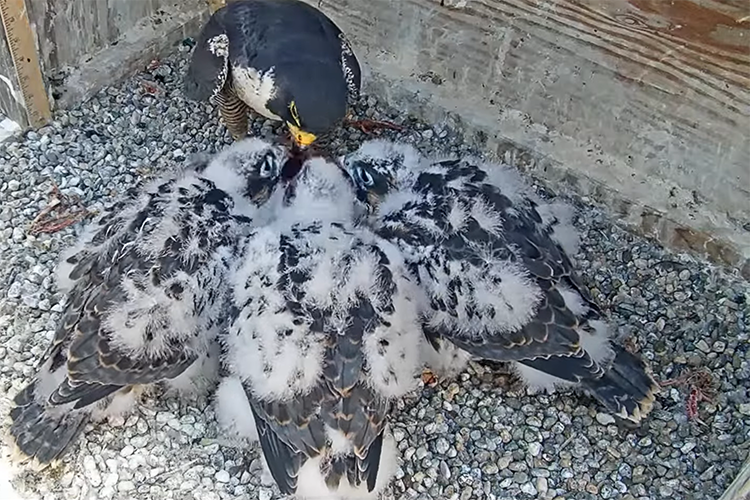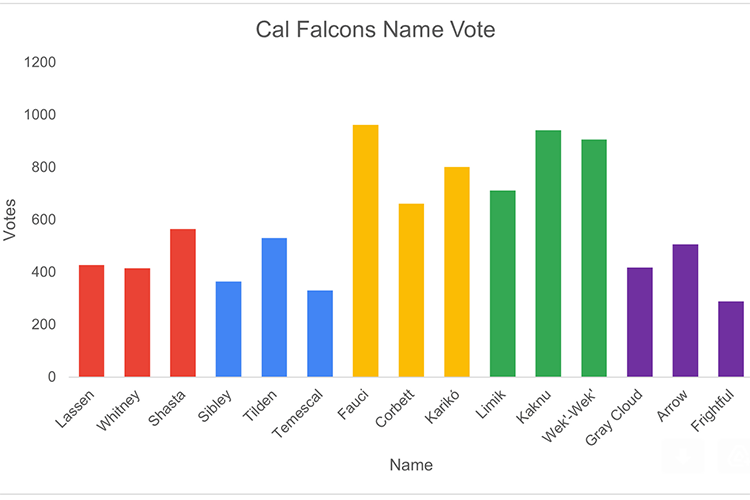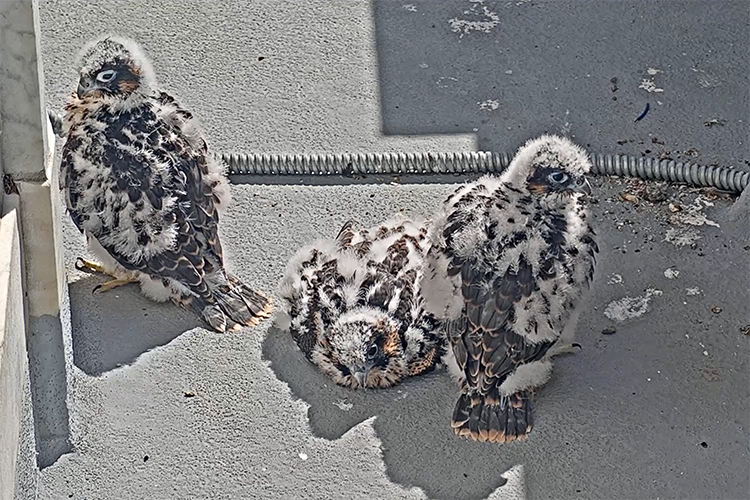Fauci, Kaknu, Wek’-wek’: Berkeley’s falcon chicks are named
Nearly 3,000 people voted on what to name the three brothers that could start fledging next week
May 20, 2021

In their nest on the Campanile, Annie feeds the three male chicks, which are growing up fast. They’re also trying to feed themselves, and a couple of them recently attempted to steal a whole bird from their mother. (Cal Falcons image)
UC Berkeley’s three new falcon chicks now share names with a COVID-19 hero and two falcon figures from Native American traditions. Fauci, Kaknu and Wek’-wek’ drew the most votes in a Cal Falcons naming contest in which nearly 3,000 people worldwide voted. Some 650 names had been suggested by the public; 15 finalists emerged on May 16.
“It became pretty clear early on that people really wanted to recognize COVID-19 and the Californian Native tribes,” said ornithologist Sean Peterson, a Berkeley Ph.D. candidate who runs the Cal Falcons social media program with biologist Lynn Schofield from the Institute for Bird Populations. “We had a lot of people campaigning for their favorites on social media. We saw a lot of messages that people felt it was really important to honor the first people to live in California, as well as the people who have guided us through the last year.”
Fauci, for Anthony Fauci, director of the National Institute of Allergy and Infectious Diseases/NIAID, received 962 votes; Kaknu, a falcon in Ohlone tradition, got 942; and Wek’-wek’, the Miwok tribe’s falcon figure, drew 906.

Fauci, Kaknu and Wek’-Wek’ were the winning names in the Cal Falcons 2021 naming contest. (Cal Falcons image)
The Berkeley chick with a red band on its leg is now Fauci; the yellow-banded chick is Kaknu and Wek’-wek’ is the name of the chick with the blue band.
Other names in the final voting were of California landmark peaks, East Bay parks, additional COVID-19 health heroes, another falcon in Native American tradition, and three names proposed by children.
Many wildlife-watching communities, like Berkeley, name the animals they watch — a practice that has benefits, said Peterson.
“It increases the emotional connection people have to that individual and may help people to get to know the animals better,” he said. “People also get really excited about naming animals. It’s always been one of the things people really look forward to during the breeding season. I think, in some ways, the naming contest is a cool way for people to share what is important to them.”

Annie keeps a close eye on a chick that’s starting to practice flapping its wings. (Cal Falcons image)
Naming animals has practical value, too.
“It does make Fledge Watch and other activities a little easier,” said Peterson. “’83/AN just flew toward Evans Hall’ is a little bit harder to say that ‘Fauci flew toward Evans Hall,’” he said. The chicks — banded on May 12 — had been known, before today, as 81/AN (blue-banded chick), 82/AN (yellow-banded) and 83/AN (red-banded).
The chicks’ new names, cross-referenced with their federal bird band numbers and color markers, appear at the bottom of the page on the Cal Falcons website, as does information on the other chicks raised by falcon parents Annie and Grinnell in past years. This data helps people keep up with the chicks after they leave the nest and tells how to report a re-sighting.
“If someone found Fauci somewhere else in the world, the (federal) Bird Banding Lab would put them into contact with Dr. Zeka Glucs, our bander, who would then probably send them our way to get the whole story,” said Peterson. “So, it’s likely that even though the name is something created by the Berkeley community, it will be associated with these birds their entire lives if they’re found by people.”

The brothers are growing “contour” or “body” feathers that cover their down and make them aerodynamic in flight. Cal Falcons says Kaknu has bright yellow feet when compared to his brothers, and that Wek’-wek’ is the youngest, so he’s got more down feathers right now. Fauci and Kaknu hatched the same day, so it isn’t known which is the oldest. (Cal Falcons image)
Peterson and Schofield said the falcon brothers, depending on how quickly they develop, will likely have acquired the feathers necessary for flight and independent activity by Friday, May 28.
“The chicks are growing in ‘contour,’ or ‘body,’ feathers. Those feathers cover the down and make them aerodynamic in flight,” said Peterson. “As anyone who is watching them right now can see, everything is happening really fast.They look more and more like adults every day.”
This Saturday, May 22, from 2:30 to 3:15 p.m., Cal Falcons will hold a special virtual event for youngsters and families, “Our Resident Raptors,” in partnership with the Berkeley Public Library. The free session, recommended for ages 3 and up and, is about the Berkeley falcons and other raptors living in the Bay Area. Register to save your place and obtain the Zoom link here.